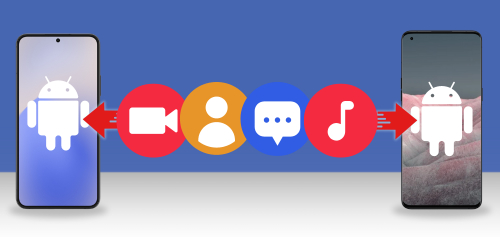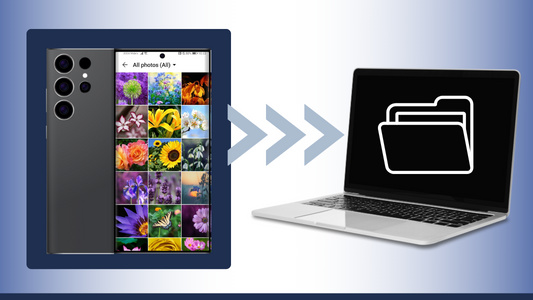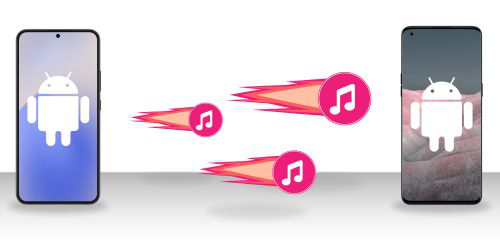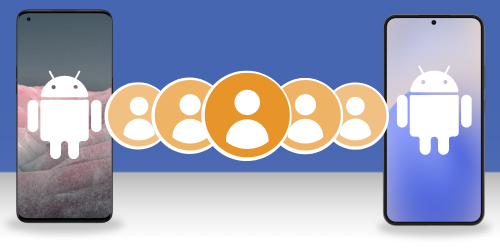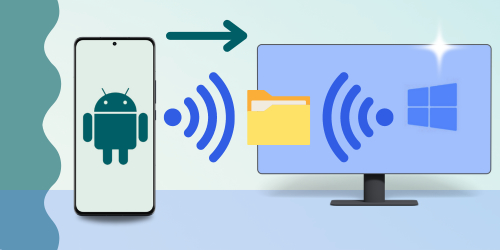Introduction
Photos often capture our most precious moments and memories. However, when you switch to a new Android device, transferring these photos can be a daunting task.
Our team of experts have tested numerous methods to create this comprehensive guide on how to transfer photos from one Android device to another, so you never have to worry about losing your photos again.
What to consider when choosing a photo transfer method
- Photo Storage: Whether you want to store your photos on an Android device itself, in the cloud, and/or locally on a computer. Storage space limitations may apply based on local hardware, and you may need to consider a paid subscription if you require more cloud space.
- Support/Compatibility: Some methods are only available on certain devices or certain versions of Android.
- Scope: Does the transfer method allow for photos only, or other content types?
Quick jump to any of the methods reviewed:
- How to transfer photos from Android to Android locally via your PC
- How to transfer photos from Android to Android via Bluetooth
- How to transfer photos from Android to Android using Google Photos
- How to transfer photos from Android to Android using Quick Share
- How to transfer pictures from Android to Android with Android Beam
- How to transfer photos to a new Android using Smart Switch
Method 1: How to transfer photos from Android to Android locally via your PC
For many, the best way to manage your photo library is on the big screen of your computer. Having your photo library local on your computer, and independent of cloud services gives you full control.
Droid Transfer is an invaluable app which allows you to transfer your Android photos to PC, and to other Android devices.
The Droid Transfer Windows PC software works in tandem with the free Transfer Companion app on your Android to allow you to access and copy all kinds of Android content, not just photos. If you have Music, Contacts, Call Logs and other files, you can copy them to your PC all from Droid Transfer!
The process here is to transfer your photos from one Android to your PC, then you are free to transfer those photos to another Android device.
- Connect the Android containing your photos with Droid Transfer (you can connect using Wi-Fi or USB cable).
- Open the Photos feature and select the photos you want to transfer.
- Click “Save to PC” and choose where to save your photos on your PC.
- Once the save is complete, safely disconnect your old Android and connect your new one.
- Open the Photos feature again and click “Add Photos to Device”.
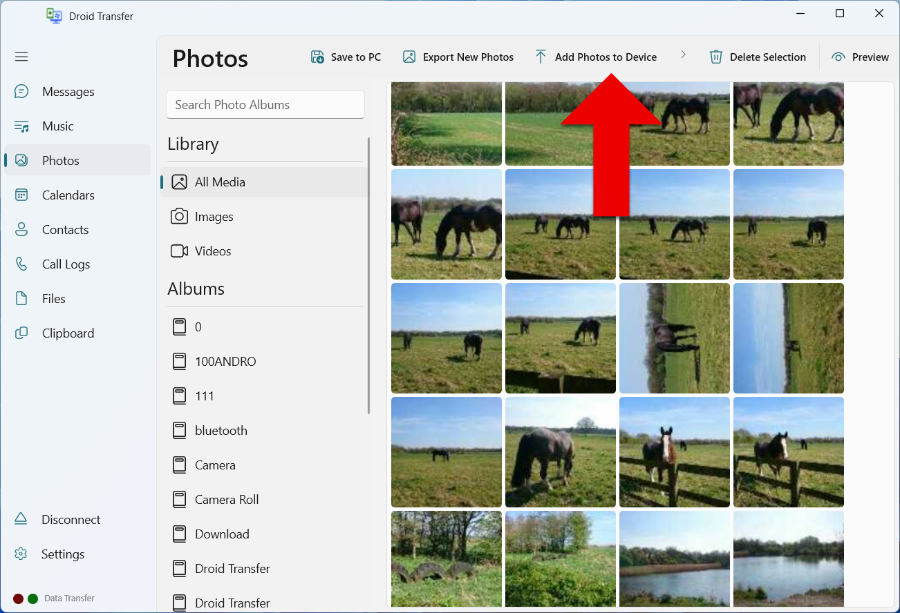
- You can choose to add an entire folder of photos or only specific photos.

- Finally, select all the photos you saved to your PC that you want to add to your new Android device!
With Droid Transfer, you also get access to an easy and efficient photo backup feature “Export New Photos”. Regularly backing up your photos to PC is sensible to ensure you keep your photos safe. Droid Transfer will automatically detect photos on your Android that you have not yet backed up to your PC, making it super easy to ensure you have a complete backup of your library.
You can copy up to 100 Android photos using the free Droid Transfer download. To unlock the full set of features and unlimited file copies you can purchase a Droid Transfer license. Droid Transfer is regularly updated and friendly customer support is ready to assist with any queries.
Advantages
- Photo Storage: Photos are stored locally on your Android devices and on your PC.
- Local transfer and storage are safe and secure, and you can access your photos without the use of the internet.
- Support/Compatibility: Droid Transfer is for PCs running Windows 10 and higher. You can use any Android device running Android 5 or higher.
- Scope: Droid Transfer is more than just transfer - it offers a plethora of Android management tools like exporting, editing, deleting, restoring and syncing.
- Ability to access and copy other Android content types like Messages, Contacts, Music, Call History and more!
- Transfer via Wi-Fi or USB cable.
- Fantastic value for money.
Disadvantages
- Indirect photo transfer. You need to copy to PC first, then copy from the PC to the new Android.
Method 2: How to transfer photos from Android to Android via Bluetooth
Bluetooth has been around for ages (since 1998!) and still remains a popular method for sending files from device to device.
Before you can transfer files, you'll first need to ensure that both devices have Bluetooth turned on and that they are paired.
To turn on Bluetooth on Android, go to Settings > Bluetooth > toggle Bluetooth ON. Then on either device's Bluetooth settings, tap “Pair new device” and tap your other Android to pair them.
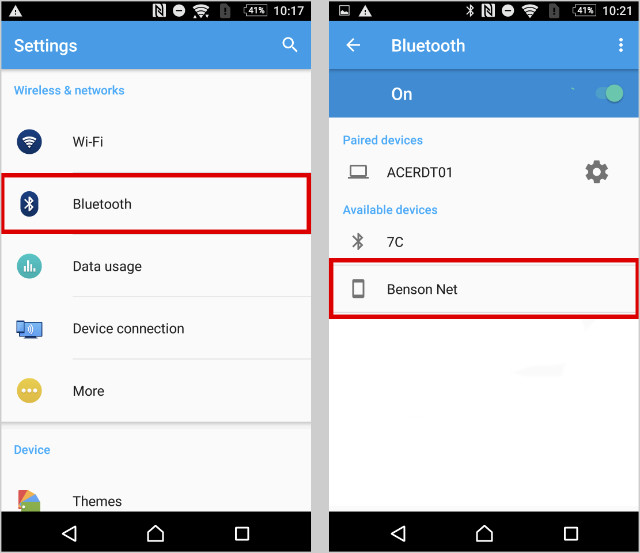
Now, here's how to transfer photos from Android to Android with Bluetooth:
- Open your photos app on the Android containing your photo library.
- Select the photos you wish to transfer (to select multiple, touch and hold one photo, then tap other photos).
- Tap Share, choose Bluetooth, then select your destination device
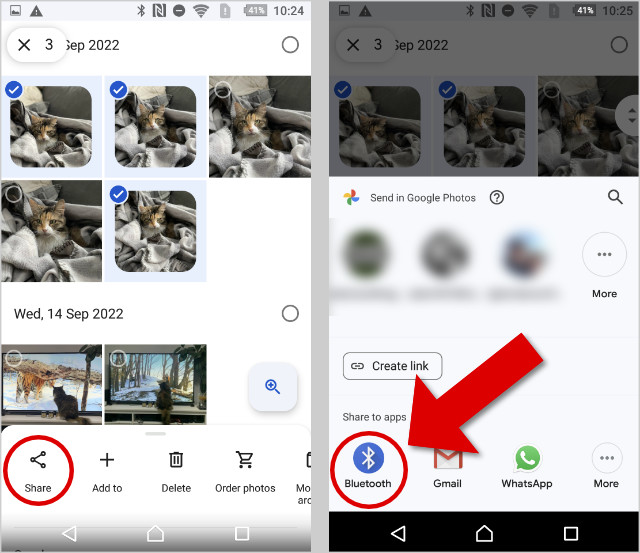
- You'll need to accept the transfer on the destination device, then the photos will begin to transfer!
Be aware that Bluetooth has historically had security concerns, as it can make a device a potential target for hackers. Ensure that you follow safe practices while using Bluetooth like keeping your device up-to-date, and turning off Bluetooth when you are not using it.
Advantages
- Wireless, direct transfer from Android to Android.
- Photo Storage: Photos are stored locally on your Android devices.
- Support/Compatibility: The vast majority of modern smartphones have Bluetooth built in.
- Scope: Transfer pictures, video, audio and other files.
Disadvantages
- Slow transfers compared to Wi-Fi or USB cable transfers.
- Low bandwidth makes it unsuitable for large transfers.
- Interference and pairing issues can cause a loss of connection.
- Can be insecure.
Method 3: How to transfer photos from Android to Android using Google Photos
Cloud storage is a fantastic method to transfer photos between devices. Using a cloud service like Google Photos, you can store your entire photo library in the cloud, rather than on your device. This could save you huge amounts of space on your mobile devices. The only downside to this is that you only get 15GB of free space in Google Photos. If you need more, you'll need to upgrade to a Google One subscription.
While your photos are saved in the cloud, you can access them on any of your devices, as long as you are connected to the internet. As such, you don't necessarily need to transfer and save photos on your Android devices - you may simply want to have the option to access them. You can always download any photos you need from Google Photos to Android.
- Open Google Photos on your first Android device and ensure you are signed in with your Google account.
- Tap your profile picture or initials in the top-right corner of the app.
- If Backup is off, tap "Turn on backup".
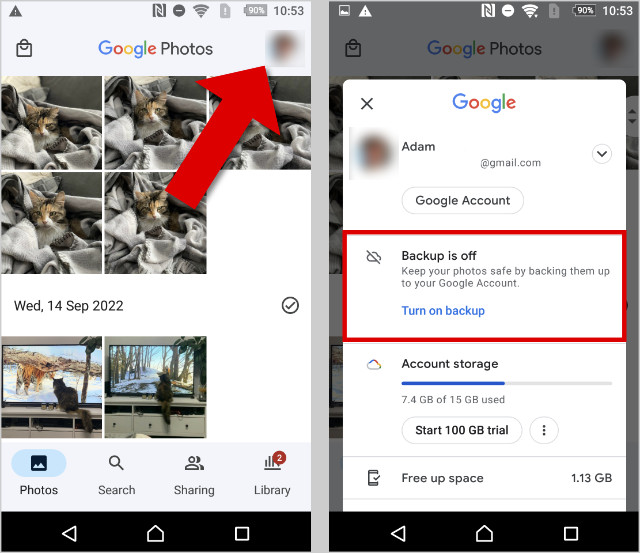
- Select the Google account you will be using on your new Android device.
- Tap "Turn on backup". The backup can take a while to complete depending on the number of photos and videos to back up, and your internet connection.
- When the backup is complete, open the Google Photos app on your new Android device and ensure you are signed into the account you backed up your photos to.
- You can now view all your backed-up photos which are saved in the cloud. To download a photo from Google Photos storage to your device, select the photo > tap More > Download.
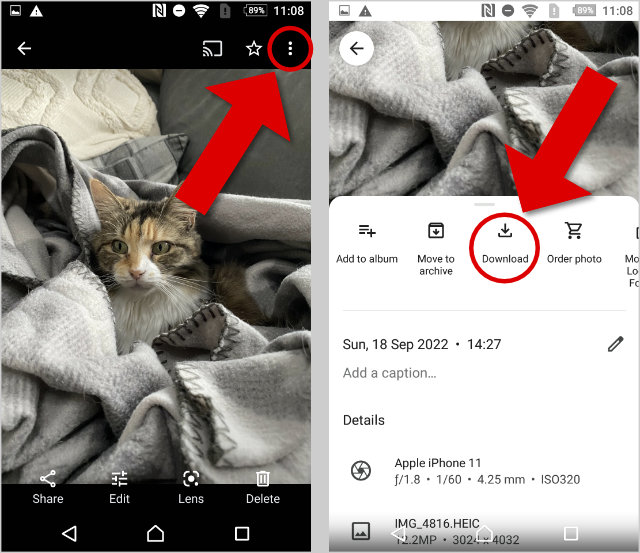
Advantages
- Fast, Easy and wireless.
- Photo Storage: Photos can be stored in the cloud, on your Android, or both.
- Support/Compatibility: Supported on all Android devices.
Disadvantages
- Scope: Transfer photos and video only. Google One / Google Drive is required for other types of content.
- Limited storage space before purchase is required.
Method 4: How to transfer photos from Android to Android using Quick Share
If you like Bluetooth, we can do better. Google and Samsung have collaborated to provide Quick Share (formerly Google's "Nearby Share"). The platform can be a faster and more efficient method to wirelessly share files between Android devices which are in close proximity to each other. It achieves this by leveraging both Bluetooth and Wi-Fi.
As mentioned in method 2, while using Bluetooth, make sure that you keep your devices up-to-date and turn off Bluetooth when you have finished using it to help ward against security issues. More top tips about keeping safe while using Bluetooth.
Quick Share supports devices using Android 6 and higher, and is pre-installed on those devices. If your device does not support Quick Share, you can use its predecessor "Android Beam" instead.
First, ensure both Android devices have Quick Share. You'll also need to ensure that Bluetooth and Wi-Fi are turned on (Bluetooth for finding other devices to connect with; Wi-Fi for fast file transfers).
Follow the steps below to transfer photos from Android to Android using Quick Share:
- Open the Photos app on your Android device.
- Select the photos you want to transfer (to select multiple, touch and hold one photo, then tap other photos).
- Tap Share at the bottom of your screen, then tap "Quick Share".
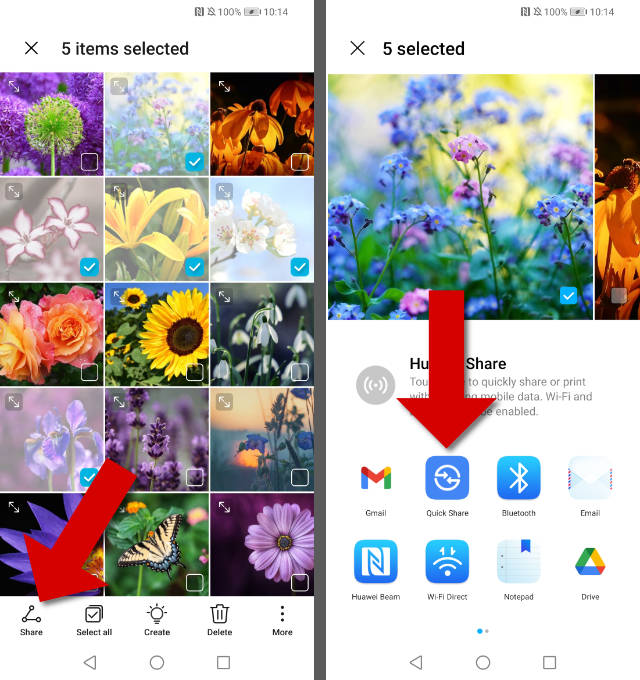
- Your device will scan for other devices nearby which have Quick Share enabled and Bluetooth turned on.
- Select the Android you want to send your photos to.
- On the recipient device, accept the transfer request to receive the photos.
Advantages
- Wireless, direct transfer from Android to Android.
- Photo Storage: Photos are stored locally on your Android devices.
- Support/Compatibility: Supported on most devices using Android 6 and higher.
- Scope: Transfer pictures, video, audio and other files.
- Fast transfers when Wi-Fi is available.
Disadvantages
- Can be insecure with the use of Bluetooth.
Method 5: How to transfer pictures from Android to Android with Android Beam
Before Quick Share, there was Android Beam. This feature was introduced in Android 4, and has been deprecated as of Android 10, with Quick Share being the preferred method to carry forward.
Android Beam uses NFC (Near Field Communication) to make a connection between two devices. This is the same technology used to allow you to make payments by touching your phone to a payment terminal in a shop. Obviously, this means that the two devices must be very close (or touching) to transfer data.
Before you get started, make sure both Android devices have NFC and Android Beam, and that both features are turned ON. In the Settings app, these features may be in different places on different devices - so if you have a "Connected Devices" option, tap that; if not, under "Wireless & Networks", tap "More". Here, ensure that you have options for NFC and Android Beam, and ensure that they are both turned ON.
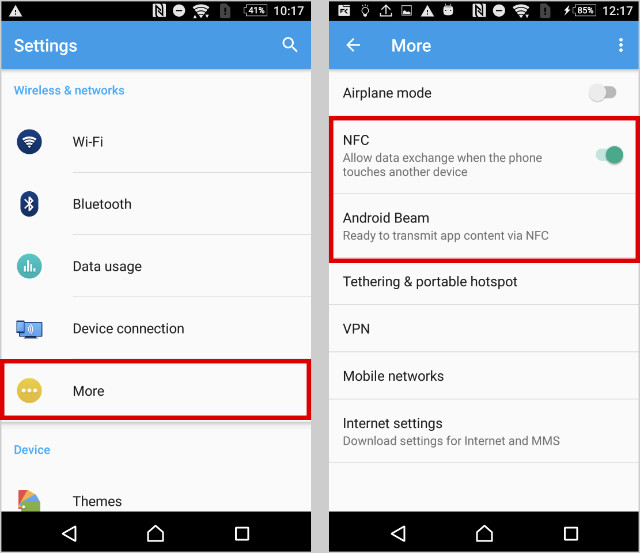
Now you can follow the steps below to transfer photos from Android to Android using Android Beam:
- On the Android containing your photos, open the Photos app.
- Select the photos you want to transfer (to select multiple, touch and hold one photo, then tap other photos).
- Ensure your Android devices are unlocked and bring the backs of both devices together.
- On the first device, you'll now have the option to "Tap to Beam" your selected photos.
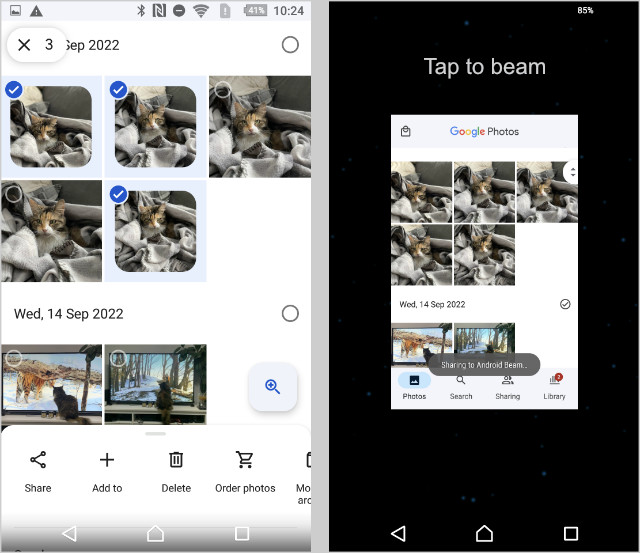
- Tap the screen to beam your photos to the other Android!
Advantages
- Wireless, direct transfer from Android to Android.
- Photo Storage: Photos are stored locally on your Android devices.
- Scope: Transfer pictures, video, audio and other files.
Disadvantages
- Support/Compatibility: Supported on some devices using Android 4 to Android 10.
- Now deprecated, so will be usable on fewer and fewer devices.
- Requires devices to be very close together (or touching).
Method 6: How to transfer photos from Android to Android using Smart Switch
Our final section is a little different in that it is for those who are switching from an old Android device to a new one. This is great if you have bought a new Android and will be recycling your old one.
Migrating your content from one device to another is a lot easier than it used to be. Many manufacturers provide their own app to help you transfer your content from your old device to their device. Samsung's content transfer app is called "Smart Switch" and helps you migrate to a new Samsung Galaxy device.
- Ensure you have the Smart Switch app on both Android devices (it will come preloaded on new Samsung Galaxy devices).
- Launch Smart Switch on your new Samsung Galaxy and tap Receive data > Galaxy/Android.
- Choose to connect via USB cable or Wi-Fi. Follow the steps to make the connection between the two Androids.
- Select all the content types you want to transfer.
- Tap Transfer. Once the process is complete, tap Done!
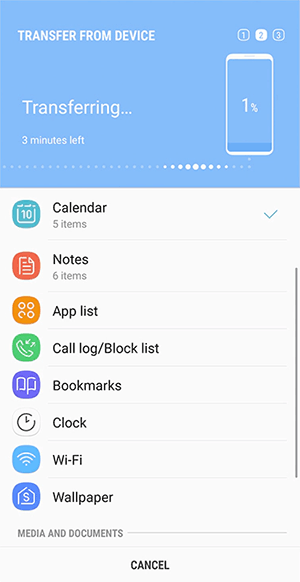
Advantages
- Direct transfers from Android to Android.
- Transfer via Wi-Fi, USB cable or via an SD card.
- Photo Storage: Photos are stored locally on the Android devices.
- Scope: Transfer photos, videos, music, messages and more.
Disadvantages
- Support/Compatibility: Supported on Android devices running 4.3 or later, but only transfers content to Samsung Galaxy devices.
Conclusion
There you have it! The ultimate guide to transferring photos from Android to Android.
You should now have all the information you need to choose the best method for you. Based on the pros and cons of each, different methods will be better suited for the requirements of different users.
- For the most powerful and complete Android management and transfer system, look no further than the Droid Transfer software. Quickly transfer photos to and from Android, and easily back up new photos regularly to your PC.
- To always have your complete library of photos available on any of your devices, use Google Photos to store your Android photos in the cloud.
- If you only have a few photos to send from one Android to another, Bluetooth or, better still, Quick Share will do the trick quickly and with minimal fuss.
 Publisher:
Publisher:Wide Angle Software


